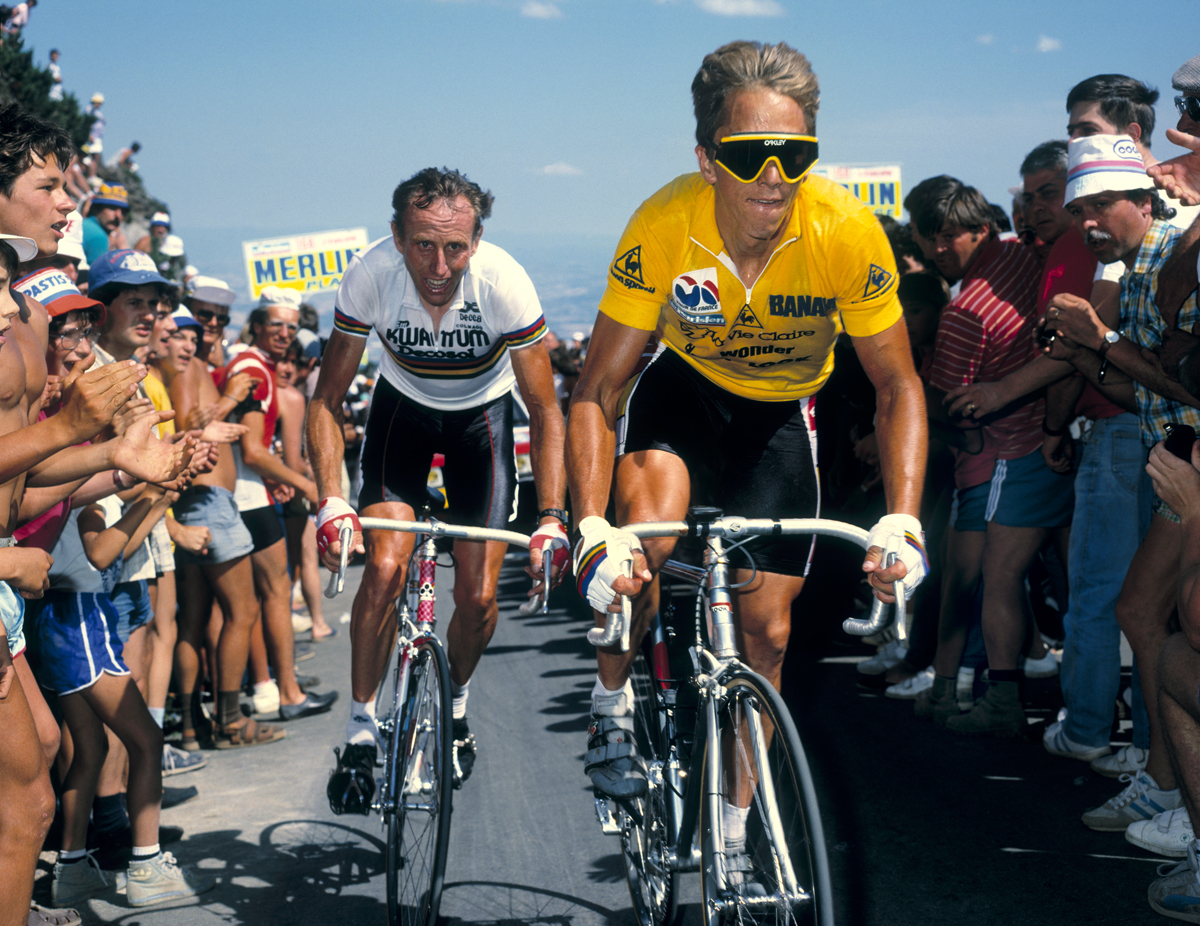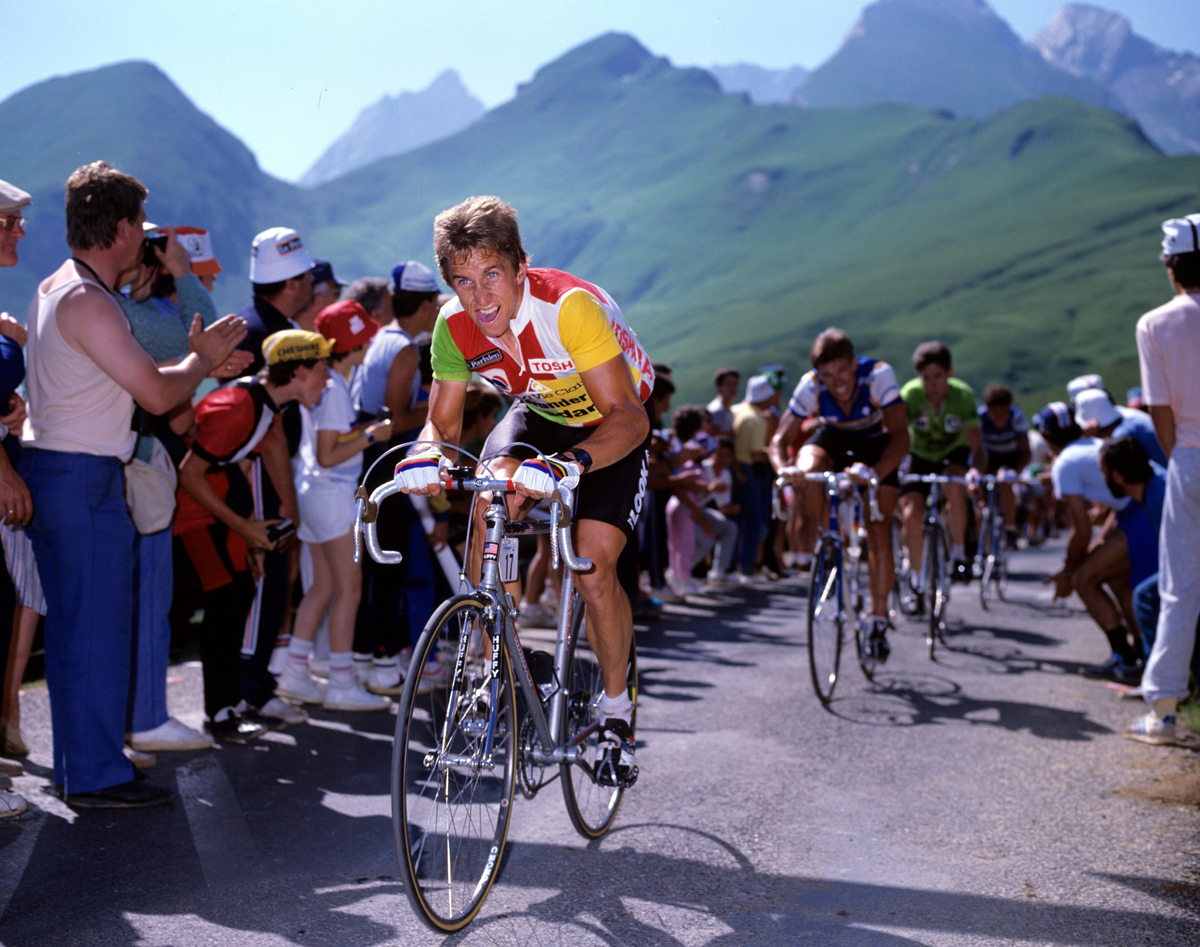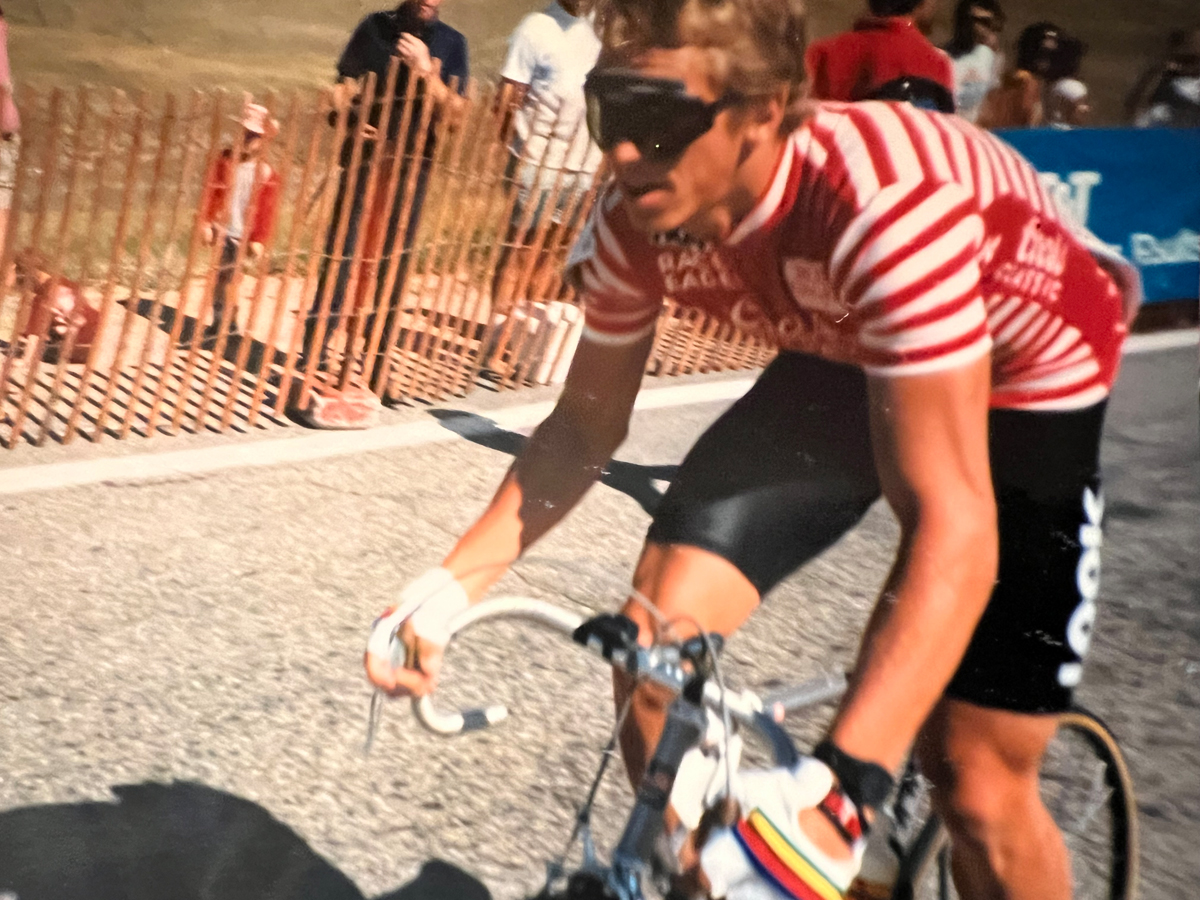An excerpt from the forthcoming book Saddling up to ride in Cowboy Country…in Spandex! A unique tale of both personal and American cycling history
By Dave Campbell — I started racing in 1981, the first year that an American rode in the Tour de France. That rider was Jonathan (Jacques) Boyer from Carmel, California. While Americans (seen by many Europeans as cowboys) struggled to make their way in the European peloton, I struggled to make my way in an exciting but exotic sport in actual “Cowboy Country” …Wyoming!
In fact, Boyer’s tour debut was such a significant event that he was allowed to ride in a stars-and-stripes jersey, despite not being the National Champion! In 1981 there was no US National Professional Championship. The US only had two other professional riders…George Mount and Greg LeMond.
“Smiling” George Mount had turned pro after the 1980 US Olympic boycott and in 1981, with almost zero fanfare, had become the first American to contest a Grand Tour, finishing 25th in the Giro d’Italia. Neo-pro Greg LeMond, Junior World Champion in 1979, was racing for the French Renault team under the tutelage of renowned coach Cyrille Guimard, Guimard was developing his protege very slowly and carefully, with a Tour de France debut still years away. Americans were suddenly starting to make their mark in professional cycling internationally!

As a junior rider in Wyoming in the early 1980s, I had to venture to Colorado to find races with sizeable fields and strong competition. In the cycling hotbed of Boulder, Colorado I competed for ten days in August of 1983 against 65 other junior riders in the Red Zinger Mini Classic. In the shops, I also found a brand new magazine: “Winning Bicycle Racing Illustrated”. It would be instrumental in fueling and informing the growth of the sport of cycling in America. Riders like me could now follow our heroes as they continued to make inroads into this esoteric and previously exclusively European sport. I bought the inaugural issue, which primarily detailed the career of Belgian Eddy Merckx, the greatest cyclist of all time and…the current issue, issue #2, that was just out!
The cover detailed “Boyer and LeMond Success Abroad” with a special focus on the 1982 Worlds Road Race in England. All three of our pros competed. This would be the first real detailed accounting I had ever read of a professional road race, and it lit me up! The magazine detailed the final exciting moments of the race blow-by-blow. Boyer had launched an attack in the final mile on the long grind to the finish. He faded to 10th but LeMond, only 21 years old and in only his second year as a pro had won the silver medal. Italian Giuseppe Saronni, the winner, was already an established star in the European peloton, but Greg beat the rest including Irishman Sean Kelly, a name I knew from the Tour de France.
More importantly, we, the United States, had two riders who were right in there at the end of the World Championship going for the win! And this young guy, only 21 years old and in his second year as a professional finished 2nd! Could he win it next year? The first ever US World Road Cycling Champion? And what about his prospects in the Tour de France? This could be “our guy”, an American who can beat the best in the world!
After reading about Greg LeMond in those Winning Magazines I brought home from Colorado and his 1982 Worlds medal, I was desperate to learn more about my new hero. As was often the case in that era, the coverage of that historic silver medal didn’t come to me until well after the fact, so I was playing catch up. I turned to … where else, but my high school library, mining the card catalog for bike racing gold on the very first day of high school! While my classmates stood in line for burgers and shakes at the local Dairy Queen, I ate my rice cakes and yogurt in the library, a student of my sport. I educated myself on my new hero Greg LeMond, and how he was taking on the world!
There was not much to be found except … a July 13, 1981 issue of Sports Illustrated with an article entitled “Goldilocks 1, Bears 0”. Young Greg vs the Big Soviet Bear! I was loosely familiar with the story of Greg defeating the Soviet Olympic Team in the Coors Classic, as the older members of my cycling club (several who “went down to Colorado to follow the Classic”) regaled us with tales at the local shop. Now I wanted all the details! In the early 1980s of Ronald Reagan’s America, and particularly in Cowboy Country, the Soviet Union was “the evil empire”. This was a looming threat to our western way of life and so when an American kicked their asses? Oh, hell yeah!
The article’s author, Barry McDermott, wrote “Now the Soviet Union has something else to worry about. It ran into Greg LeMond! The dimple-chinned, blonde-haired, rosy-cheeked Yankee Doodle Dandy from Washoe County, Nevada took on the older, more seasoned Soviet stars in the torturous nine-day stage race in the Rockies!”
What a script! Race promoter Michael Aisner had a flair for the dramatic and so, following the American boycott of the 1980 Olympics (where the Soviets dominated) he invited them to race America’s premier event!
The Pro-Am event, then in its seventh year featured eleven stages in Colorado in July with a mixture of high-altitude road races featuring big climbs, downtown criteriums, and time trials. In the excellent Drake/ Ochowicz book “Team 7-Eleven,” Aisner recounted: “I got letters from racers, who were friends, who said the Russians will come and take all the prize money away! Why would you do this? It will ruin the race!” He noted his unwritten response was “Get off your asses and beat them!” One racer who responded positively? Greg LeMond! He said “Bring ’em on! I’ll show them which wheel to get on!”
LeMond, who was barely 20 years old when the Coors started, was in his first year as a professional with the Renault-Gitane team led by Bernard Hinault. His astute director Cyrille Guimard only wanted his protege to gain experience that year … and focus on a few races including the Dauphiné Libéré and the Coors Classic. He helped Hinault win Paris-Roubaix in April, finished third behind his team captain in June’s Dauphiné, and then headed to America with a young French team to race the Classic!
Coors promoter Aisner noted that the Russians brought their very best riders and were “supremely confident” of winning the 538-mile event and the lion’s share of the $50,000 purse.
“They came not just to win, but to embarrass!” Greg LeMond explains. “Facing Sergei Soukouroutchenkov and Yuri Barinov, The Olympic Gold and Bronze Medalists, was for me a real test of who would have been Olympic Champion. This was my real revenge on missing the Olympics because of the boycott.” LeMond had been a favorite for an Olympic Gold medal following a strong spring campaign with the US National team in Europe. It included an historic first American victory in a major European Pro-Am Stage Race, France’s Circuit de la Sarthe, and ultimately helped land him that 1981 pro contract.
LeMond won the Prologue Time Trial but then Russian Yuri Kashirin took over the Red Leader’s Jersey after the high-altitude Bob Cook Memorial Road Race. Miffed at how intimidated his countrymen were by the Russians, LeMond was keen to race on all terrains, even earning bonus seconds in field sprints in the criteriums!
On Stage seven, the “Suicide Hill” circuit race in Snowmass, a torturous up/down, “LeMonster” broke clear with Colombian Noberto Cesares, ultimately winning the stage and putting four minutes into the Russians. Later in that afternoon’s time trial, his second place allowed him to pull on the leader’s jersey, for good this time.
On the penultimate stage, the Morgul-Bismark road race, the entire Soviet team broke clear and only LeMond could stay with them. LeMond recalls “We went head-to-head, me against four Russians on the Morgul Bismark course. They tried every which way to drop me and every time they’d attack, I’d chase one guy down. I would slow just before I caught him and then as the other group caught up, just before they caught, I’d attack and drop everyone. Then I’d slow down and when they caught me, they’d send somebody off and I would go after him. I just played this game with them, four against one, and they couldn’t drop me.”
With only the North Boulder Park Criterium remaining, Greg had a nearly five minutes overall lead, while the Russians lay 2nd-5th on GC and would have to be content with the team prize. 40,000 spectators gathered in Boulder’s cycling mecca, and even a last lap crash (“I over-cooked the last corner”) couldn’t keep LeMond from overall victory. And that, I found was the story of how Greg LeMond defeated the mighty Russians or as Sports Illustrated wrote: “Goldilocks slayed the FOUR Bears!”
It was an All-American success story kind of like “The Miracle on Ice”, only in this exotic sport that I was falling in love with. My sport! His irrepressible drive to succeed, ability to overcome adversity, and win against all odds would serve him well in the years to come. I loved his attitude! This was my guy and from then on, I rabidly followed the incredible story of Greg LeMond.
Perhaps more importantly for America as a fledgling cycling power, Greg was proving to be our guy! According to those Winning magazines I was studying intensely, Jonathan Boyer became only the first American to ride the Tour de France in 1981, finishing a credible 32nd. He improved to 23rd the following year and was 12th in 1983. LeMond, under his brilliant and calculating coach Guimard, whose riders had triumphed in five of the previous seven Tours up to that point, was being carefully built up for his debut in 1984. I wondered what “LeMonster” do in the Tour de France? I had to think he could be a contender. This really could be our guy!
A few weeks later, Bob Moon, proprietor of my local bike shop Freewheel Sports, returned from a bike tour around Europe. He even watched the World Pro Road Championships in Switzerland! And, he informed me LeMond had won it! Greg LeMond was the World Champion! He went in a break with a couple laps to go and by the final lap he was solo! He won alone by over a minute! An American cyclist was World Professional Road Champion and would wear the rainbow jersey in the European peloton during the 1984 season!
LeMond, in the rainbow jersey of reigning World Champion, ended 3rd in his debut Tour and won the White Jersey as best young rider. Plagued by bronchitis and sore feet, he languished in 8th place with a week to go. Guimard stated Greg was “riding the Tour on one leg”. Greg, however, as he would show again and again, is something very special. He fought back in the final week in the Alps, to make the podium. He was joined there by American Marianne Martin who had won the inaugural but sadly short-lived Tour de France Féminin. He had given all Americans hope that a male American Tour winner was not that far away.

Greg finished a disappointed 2nd the following year to team leader Bernard Hinault in a race many, including Greg, thought he should have won. The final margin was barely a minute after Greg waited for an injured Hinault on the mountain stage to Luz Ardiden. In a breakaway with third-placed Stephen Roche, Greg’s French team staff misinformed him of the gap to Hinault behind. Rather than aid Roche in moving past the Frenchman, the American was ordered to wait. He later realized that the gap to Hinault was much larger than he had been told, and he had thrown away a winning opportunity. Hinault, meanwhile, won his fifth Tour joining all-time greats Eddy Merckx and Jacques Anquetil. After LeMond rallied to win the final time trial, Hinault pledged his support to the American for the 1986 edition, stating to the press “next year I will suffer for him as he has sacrificed for me”.

It was after the 1985 Tour that I met my hero in person. Just 16, my best friend and training partner and I drove down to Boulder to watch the final two stages of the Coors Classic. And not just any Coors, but a mountainous California/Nevada/Colorado edition that featured the La Vie Claire team (rebadged as Celestial Seasonings Red Zinger for the event) of LeMond and Hinault. I was going to cheer and hopefully meet my hero. After crashing with a friend, we rode our bikes out to the stage with many others. So many people had turned out! The American cycling cult was out in force! We didn’t catch Greg, the race leader, prior to the start but we strategically waited by the doping control trailer after the race. No one else was there. Within five minutes, the door opened and there was my main man, Greg!
“Hi, guys!” he boisterously exclaimed. “Are you bike racers?”
“We are!” we proudly responded.
He signed our hats, our books, smiling and taking time to talk with us and listen to us. I told him I knew he would win the Tour next year. He said he appreciated that. What an ambassador of the sport and just a nice guy. He was one of us!
The 1986 Tour, well documented in Richard Moore’s excellent book “Slaying the Badger”, was one for the ages and LeMond overcame his team leader Hinault, who constantly raced against him, to become America’s first Tour de France champion. Further American history was made by the participation of the first ever American team, 7-Eleven, who won a stage (Davis Phinney) and enjoyed a day in the yellow jersey (Canadian Alex Stieda).
Greg’s incredible story was not over, however.
In the spring of 1987, while recovering from an early season injury, LeMond’s brother-in-law shot him in a hunting accident and he was unable to defend his title. Injuries and illness kept him out of the race again in 1988, but he returned in 1989 to win what many consider the greatest Tour of all time on the final day by only 8 seconds. Later that year, he won his second world road title and in 1990, again wearing the rainbow jersey, he would win his final Tour de France.
After the disqualification of Lance Armstrong for years of systematic doping, Greg LeMond, along with Marianne Martin, who won the 1984 Tour Féminin, remain the only American winners of the Tour de France.
References:
Drake, Geoff with Ochowicz, Jim. (2011) Team 7-Eleven: How an Unsung Band of American cyclists took on the World and Won. Velopress.
McDermott, Barry. “Goldilocks 1, Bears 0”. Sports Illustrated, 13 July 1981, https://vault.si.com/vault/1981/07/13/goldilocks-1-bears-0-actually-the-soviets-did-win-the-team-title-in-the-coors-classic-but-nevadas-greg-LeMond-stunningly-took-individual-honors-to-become-the-uss-fair-haired-boy.









He was almost as good as the other American that won 7 TdF!
Silly article title. We all know Lance Armstrong won 7 TdF’s. We all know that many other winners were never tested, or used and passed said tests. No need to make things up… Greg Lemond was a worthy champion (he may have doped, he may not have, regardless he won those 3 years).
Comments are closed.